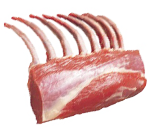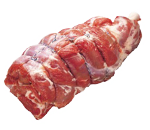Lamb Cuts


Lamb Leg, on the bone, derived from the leg of the animal. The leg will typically weight several kgs.

Easy to carve Lamb leg with the bone removed. Also perfect for dicing or cutting into strips for casseroles, curries and slow cookers.

Lamb Leg is celebrated around the world as one of the most versatile and highly flavoursome cuts suitable for roasting. Easy Carve Leg Roast comprises the front lamb leg, de-boned and rolled (with shank in). This is a great value option for lamb roasts and as the name suggests is easy to carve!

Boneless steaks may be taken from the boned out leg primals such as rump or topside. Perfect on the grill or BBQ.

The chump chop is derived from behind the loin. Chump chops have a round bone. Chump Chops are well suited to barbecuing.

Lamb rump is a superb cut of meat – a restaurant favorite! Rump is a solid square of prime muscle with a slight fat covering on the top, which adds to the excellent flavour.

As the name suggest, lamb tenderloin is very tender with a velvety texture. They are much smaller than beef tenderloins and therefore quick to cook. They can be roasted whole or sliced into medallions for a variety of dishes. Each tenderloin is usually a good portion for one person.

Loin meat is very tender. The loin eye may be removed and cut into medallions or noisettes. Eye Of Loin are best cooked using a dry-heat method such as broiling, grilling or roasting.

Loin chops are cut from the lamb‘s back, directly behind the ribs, running down the spine towards the animal’s hindquarters. Lamb loins tend to be cut into thick chops, and they’re meatier than their delicate rib chop counterparts. Loin chops are well-suited to high-heat cooking methods like searing, broiling, or grilling.

A boneless loin roast comes from the loin portion of the lamb. The boneless are removed and the roast is then strung to hold its shape. Regarded as one of the most tender pieces of meat, this cut is ideally suited for roasting.

Frenched Cutlets are prepared from the rack of lamb and the bones are “Frenched”, the rib bones are exposed by cutting off the fat and meat covering them. Frenched cutlets are relatively small; however, full of flavour and are very tender. Cutlets are ideally suited to be pan fried, char grilled or barbecued.

French Rack, (‘French-Trimmed’), is an attractive bone-in roast that is one of the finest cuts of lamb. It looks spectacular and it’s incredibly easy to carve into individual cutlets.

A “rack” of lamb is a section of ribs, usually comprised of 7 or 8 lamb chops. A classic way to prepare rack of lamb is with the bones “Frenched” or exposed.

The Forequarter Chop is derived from the Forequarter. It is an economical cut that is often best cooked slowly using either a moist method, such as braising or stewing, or by slow roasting.

Forequarter rack is cut from the forequarter neck and under the shoulder of the lamb. Forequarter rack can be slightly rough and chewy and therefore ideally suited to moist cooking methods such as stewing and braising.

Easy carve Shoulder Roast is a boneless roast derived from the shoulder of lamb. Easy Carve Shoulder roasts are typically tender and succulent when slow cooked or roasted.

Rolled shoulder of lamb is a great tasting roasting joint. Shoulder is often perceived as a more humble lamb joint and on the tougher side of tender. A less expensive, sound alternative to leg which benefits from slow roasting. Garlic and rosemary can easily be inserted into the rolled layers for exceptional added flavor.

Foreshank is prepared from a forequarter while a hindshank is prepared from a leg. Shanks are best cooked in a moist environment oven a long period.

Lamb Neck chops are considered an old fashioned cut that are full of flavour due to the meat sitting close to the bone. They are suited to being cooked slowly for inexpensive and healthy stews, casseroles or soups. Lamb necks are considered the basis for the traditional Irish Stew. Alternatively, the Greek-Cypriot way is to marinate overnight in olive oil, garlic and lemon zest and juice for grilling.

The term ‘diced” refers to the way the lamb meat is cut into small pieces often resembling cubes. Diced lamb pieces are often suited to stews, curries, stir-fries and even baked dishes such as pies.

Lean lamb mince is derived from lamb trimmings and offcuts. Lean lamb mince can be as high as 90% fat free meat.

Stirfry cuts may be derived from a variety of primals but are typically from the leg, such as the round or topside.

Lamb Leg, on the bone, derived from the leg of the animal. The leg will typically weight several kgs

Easy to carve Lamb leg with the bone removed. also perfect for dicing or cutting into strips for casseroles, curries and slow cookers.

Lamb Leg is celebrated around the world as one of the most versatile and highly flavoursome cuts suitable for roasting. Easy Carve Leg Roast comprises the front lamb leg, de-boned and rolled (with shank in). This is a great value option for lamb roasts and as the name suggests is easy to carve!

Boneless steaks may be taken from the boned out leg primals such as rump or topside. Perfect on the grill or BBQ.

The chump chop is derived from behind the loin. Chump chops have a round bone. Chump Chops are well suited to barbecuing.

Lamb rump is a superb cut of meat – a restaurant favorite! Rump is a solid square of prime muscle with a slight fat covering on the top, which adds to the excellent flavour.

As the name suggest, lamb tenderloin is very tender with a velvety texture. They are much smaller than beef tenderloins and therefore quick to cook. They can be roasted whole or sliced into medallions for a variety of dishes. Each tenderloin is usually a good portion for one person.

Loin meat is very tender. The loin eye may be removed and cut into medallions or noisettes. Eye Of Loin are best cooked using a dry-heat method such as broiling, grilling or roasting.

Loin chops are cut from the lamb‘s back, directly behind the ribs, running down the spine towards the animal’s hindquarters. Lamb loins tend to be cut into thick chops, and they’re meatier than their delicate rib chop counterparts. Loin chops are well-suited to high-heat cooking methods like searing, broiling, or grilling.

A boneless loin roast comes from the loin portion of the lamb. The boneless are removed and the roast is then strung to hold its shape. Regarded as one of the most tender pieces of meat, this cut is ideally suited for roasting.

Frenched Cutlets are prepared from the rack of lamb and the bones are “Frenched”, the rib bones are exposed by cutting off the fat and meat covering them. Frenched cutlets are relatively small; however, full of flavour and are very tender. Cutlets are ideally suited to be pan fried, char grilled or barbecued.

French Rack, (‘French-Trimmed’), is an attractive bone-in roast that is one of the finest cuts of lamb. It looks spectacular and it’s incredibly easy to carve into individual cutlets.

A “rack” of lamb is a section of ribs, usually comprised of 7 or 8 lamb chops. A classic way to prepare rack of lamb is with the bones “Frenched” or exposed.


Forequater rack is cut from the forequater neck and under the shoulder of the lamb. Forequater rack can be slightly rough and chewy and therefore ideally suited to moist cooking methods such as stewing and braising.

Easy carve Shoulder Roast is a boneless roast derived from the shoulder of lamb. Easy Carve Shoulder roasts are typically tender and succulent when slow cooked or roasted.

Rolled shoulder of lamb is a great tasting roasting joint. Shoulder is often perceived as a more humble lamb joint and on the tougher side of tender. A less expensive, sound alternative to leg which benefits from slow roasting. Garlic and rosemary can easily be inserted into the rolled layers for exceptional added flavor.

Foreshank is prepared from a forequarter while a hindshank is prepared from a leg. Shanks are best cooked in a moist environment oven a long period.

Lamb Neck chops are considered an old fashioned cut that are full of flavour due to the meat sitting close to the bone. They are suited to being cooked slowly for inexpensive and healthy stews, casseroles or soups. Lamb necks are considered the basis for the traditional Irish Stew. Alternatively, the Greek-Cypriot way is to marinate overnight in olive oil, garlic and lemon zest and juice for grilling

The term ‘diced” refers to the way the lamb meat is cut into small pieces often resembling cubes. Diced lamb pieces are often suited to stews, curries, stir-fries and even baked dishes such as pies.

Lean lamb mince is derived from lamb trimmings and offcuts. Lean lamb mince can be as high as 90% fat free meat.

Stirfry cuts may be derived from a variety of primals but are typically from the leg, such as the round or topside.